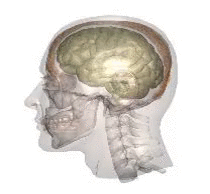In order to understand why this myth is incorrect you have to learn a little about the anatomy of the skull. The inside of the skull isn’t smooth like the inside of a bowl. The base of the inside of your skull is rough with several bony ridges or spikes. These ridges can cause an injury to the brain during periods of rapid acceleration and deceleration (when the head is “whipped” back and forth).
The sponge bucket analogy: The easiest way I have found to explain how the brain can suffer an injury without the head being struck is to think of a sponge floating in the middle of a bucket of water.
The bucket represents your skull. The water is the cerebrospinal fluid. The sponge is your brain. If you swing the bucket back and forth, the sponge will float in the center of the bucket. But if you suddenly stop swinging the bucket the sponge will bump against the inside of the bucket.

Your brain can be injured without hitting your head
This type of injury commonly happens in rear-end or head-on collisions where the driver’s or passenger’s head suddenly whips back and forth. The French phrase for this type of injury is known as a “coupe – contracoupe injury”. When the head whips back and forth and stops suddenly, the sudden stop causes the brain to bump up against the inside of the skull. Damage to the brain occurs at the area of impact.
Do You Think You Need Our Help?
Halifax Brain Injury lawyer John McKiggan Q.C. has served on the board of the Brain Injury Association of Nova Scotia (Halifax Chapter) and is the author of Brain Matter: The Survivor’s Guide to Brain Injury Claims an educational resource for brain injury survivors and their families.
If you or someone in your family has suffered a traumatic brain injury, you can call brain injury lawyer John McKiggan Q.C. toll free at (877) 423-2050 or contact us online for a free consultation.











